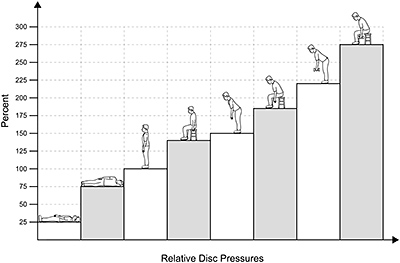Stuart McGill, PhD, emphasizes the avoidance of lumbar flexion and maintaining "neutral spine" in low back rehabilitation and everyday life. Consider his logic: The lumbar discs are under maximal load at 30 degrees of lumbar flexion; when this position is combined with compressive loading and/or repetitive insult, the discs will fatigue.
McGill's approach to lumbosacral rehabilitation is logical. Retraining movement patterns with the lumbar spine in neutral reduces repetitive insult on the lumbar discs and provides long-term stabilization of the region. His principles revolve around creating "stiffness" of the lumbar spine to allow for optimal arthrokinematics and motor efficiency.
 FIG 1 Relative change in pressure in the L3 disc in vivo based on position.
Note: For the sake of this article, the term neutral spine refers to the lumbar lordosis being in relative neutral, not in excessive flexion or extension.
FIG 1 Relative change in pressure in the L3 disc in vivo based on position.
Note: For the sake of this article, the term neutral spine refers to the lumbar lordosis being in relative neutral, not in excessive flexion or extension.
In developing this concept of neutral spine lumbar rehabilitation, McGill measured the spinal compression load created by common exercises, thus determining activities to be avoided as well as those to be encouraged.
Compare the amount of compression created by a hanging bent-knee leg raise (an exercise frequently done by low back pain patients because it is believed to reduce the compression on the low back) versus the quadruped (aka, bird-dog) exercise, which clearly produces minimal loading on the lumbar discs. (Fig. 2) Therefore, the logic in McGill's approach to lumbosacral rehabilitation is to not only maintain neutral spine, but also to include exercises with the least compressive load on the discs.
 FIG 2 Compressive load on the lumbar spine of common exercises.
Applying McGill's concept of rehabilitation to the patient with low back pain involves training or "grooving" everyday movement patterns while maintaining neutral spine positioning. For example, if getting up and down from a seated position is performed in flexion, we are back to repetitive loading of the lumbar discs, whereas if done in neutral spine the compressive load and microtrauma are less. (Fig. 3). A common mechanical dysfunction in these patients is the inability to shift the buttocks back and "hinge" from the hips; hence, they flex from the lumbar spine.
FIG 2 Compressive load on the lumbar spine of common exercises.
Applying McGill's concept of rehabilitation to the patient with low back pain involves training or "grooving" everyday movement patterns while maintaining neutral spine positioning. For example, if getting up and down from a seated position is performed in flexion, we are back to repetitive loading of the lumbar discs, whereas if done in neutral spine the compressive load and microtrauma are less. (Fig. 3). A common mechanical dysfunction in these patients is the inability to shift the buttocks back and "hinge" from the hips; hence, they flex from the lumbar spine.
Retraining Hip-Hinge Mechanics
An excellent exercise to retrain proper hip-hinge mechanics is the ball squat. Simply place your patient with feet hip-width apart and straight ahead with a physioball behind them against the wall. Have the patient squat to no more than chair height, rolling down the ball and ensuring their hips hinge and buttocks glide under the ball. This can also be done as a "sit to stand" exercise with proper instruction if you do not have a physioball in your office. Regardless, the caveats in these exercises are as follows (instruct the patient):
- Brace abdominal musculature first.
- Keep the spine in neutral position at all times – including the cervicothoracic region (no lumbar flexion).
- Do not go below chair height (90 degrees of knee flexion).
 FIG 3 The left image depicts a poor hip hinge and lumbar flexion while sitting. The right reflects sitting with the lumbar spine in neutral.
Training Lumbar Spine Stiffness
FIG 3 The left image depicts a poor hip hinge and lumbar flexion while sitting. The right reflects sitting with the lumbar spine in neutral.
Training Lumbar Spine Stiffness
McGill has three main exercises he uses to train lumbar spine stiffness in ADLs: the curl-up, the quadruped (bird-dog) and the side plank. Each has progressions from entry level to advanced by modifying the lever arm, as well as adding resistance, dynamic movement patterns, liable surfaces and functional movement patterns. Regardless of the exercise and progression, maintaining a neutral spine is essential.
The patient is allowed to progress to a more advanced exercise only when they can perform the current level properly, with lumbar spine stiffness and in neutral for 3-4 sets of 15-20 repetitions. If they cannot maintain neutral spine in a particular exercise, reduce the repetitions, provide an easier version of the exercise or change it out altogether.
McGill's approach on rehabilitation and performance enhancement for the lumbar spine is based on biomechanics. Retrain proper mechanics in everyday life; avoid lumbar flexion; and reinforce spinal stiffness with activity. His texts and papers are well-referenced and his EMG studies to support his approach are voluminous and worth reading.
The next article in this series will cover the proper technique and progression of these exercises for in-office application.
Editor's Note: View larger versions of all three figures in the December digital edition of DC.
References
- Lee BC, McGill SM. Effect of long-term isometric training on core/torso stiffness. Strength Cond Res, 2015 Jun;29(6):1515-26.
- Badiuk BW, Andersen JT, McGill SM. Exercises to activate the deeper abdominal wall muscles: the Lewit: a preliminary study. Strength Cond Res, 2014 Mar;28(3):856-60.
- Castanharo R, Duarte M, McGill SM. Corrective sitting strategies: an examination of muscle activity and spine loading. J Electromyogr Kinesiol, 2014 Feb;24(1):114-9.
- McGill SM. Low Back Disorders, Evidenced Based Prevention and Rehabilitation. Human Kinetics, 2002.
Click here for more information about Donald DeFabio, DC, DACBSP, DABCO.





